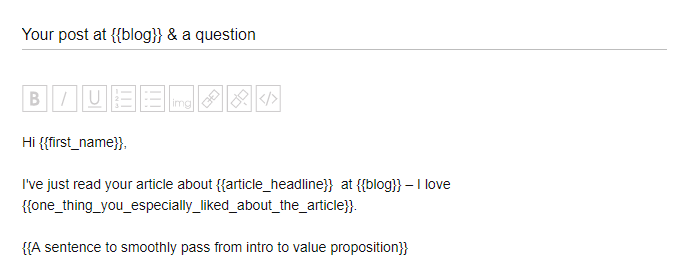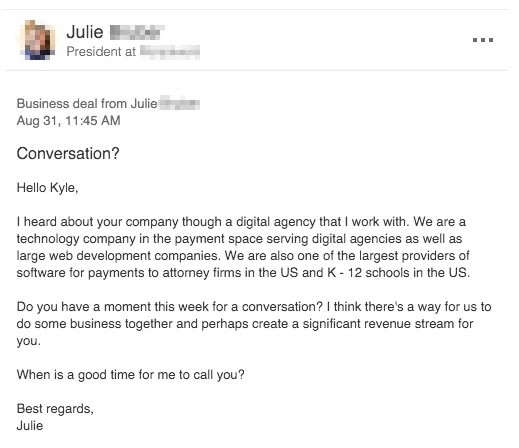Sending a cold email can seem daunting. It’s a crucial skill for networking.
But, with the right approach, it can be very effective. Cold emails are emails sent without prior contact. They are common in sales, job hunting, and networking. Success depends on how well you craft your message. Good cold emails are clear, concise, and compelling.
They grab attention and prompt action. In this post, we will explore the essential steps to send a cold email. You’ll learn to write emails that stand out. We’ll cover tips to make your email relevant and engaging. By the end, you’ll feel confident sending cold emails that get responses. In addition to crafting an intriguing subject line, understanding your audience is crucial for success. By incorporating cold email best practices, you can tailor your message to resonate with your recipient, increasing the likelihood of a positive response. Remember, the goal is to establish a connection and provide value from the very first line.

Credit: woodpecker.co
Crafting The Perfect Subject Line
Crafting the perfect subject line is crucial when sending a cold email. It’s the first thing your recipient sees. It determines whether your email gets opened or ignored. A compelling subject line can make all the difference. Let’s explore some effective strategies.
Keep It Short And Sweet
Short subject lines grab attention quickly. They are easy to read and understand. Aim for 5-8 words. Avoid unnecessary words or phrases. Be direct and to the point. Clear and concise subject lines work best. They respect the reader’s time.
Create A Sense Of Urgency
Urgency encourages immediate action. Use words that prompt quick responses. Phrases like “Limited Time Offer” or “Act Now” can be effective. Make the reader feel they might miss out. Urgency drives engagement. It adds importance to your email.
Personalizing Your Email
Sending a cold email can be intimidating. Personalizing your email can make a big difference. A personalized email shows that you have done your homework. It helps you stand out from the crowd. Here are some tips to personalize your email effectively.
Use The Recipient’s Name
Always use the recipient’s name. It makes your email feel more personal. It shows respect and attention to detail. For example, start your email with “Hi John,” instead of a generic greeting. This small step can make your email more engaging.
Reference Their Work Or Interests
Show that you know about their work. Mention a recent project or article. This shows that you are interested in them. It also makes your email relevant. For example, you could say, “I enjoyed your recent article on marketing trends.” This can help build a connection.
Writing A Compelling Opening
Writing a compelling opening for your cold email can make all the difference. The first few sentences determine if the recipient will keep reading or hit delete. A strong opening grabs attention and sets the tone for the rest of your message. This section will guide you through crafting an engaging start for your cold email.
Grab Attention Immediately
Your opening line should grab the reader’s attention right away. Use a question or a bold statement. Mention something specific about the recipient. Personalization shows that you did your homework. Avoid generic phrases. Make it relevant to the recipient’s interests or needs.
Introduce Yourself Briefly
After grabbing attention, introduce yourself briefly. Keep it short and to the point. State your name and your role. Mention the company you represent. This adds credibility. The recipient should know who is reaching out and why. Make sure your introduction flows naturally from your opening line.
Presenting Your Value Proposition
Sending a cold email can be challenging. The key to success lies in how you present your value proposition. This is your chance to show the recipient why they should care. Your value proposition needs to be clear, concise, and focused on the benefits they will gain. Additionally, it’s important to personalize your message to the recipient’s specific needs and interests. Researching their background or recent achievements can help you tailor your approach effectively. Understanding how to craft an effective cold email will significantly increase your chances of receiving a positive response.
Focus On Benefits
When you write your cold email, emphasize the benefits. Recipients want to know what’s in it for them. Focus on how your product or service will improve their situation. Additionally, provide clear examples or case studies that demonstrate the positive impact your offering has had on similar clients. This social proof can bolster your credibility and help recipients visualize the benefits for themselves. To master how to craft effective cold emails, consider personalizing your message to resonate with the specific challenges your audience faces.
- Will it save them time?
- Will it save them money?
- Will it make their job easier?
Answering these questions helps highlight the benefits. Make sure these benefits are clear in your email. This increases the chance of getting a response.
Be Clear And Concise
In a cold email, clarity is key. Avoid long sentences. Use simple words. State your value proposition in one or two sentences. The recipient should understand your message quickly.
Here’s an example:
Our tool reduces your admin time by 50%. This lets you focus on growing your business.
This example is clear and concise. It quickly shows the benefit. Remember, your email should be easy to read.
Using short paragraphs also helps. It makes your email less daunting. The recipient is more likely to read it. Keep your email focused on the key points.
| Tip | Explanation |
|---|---|
| Be Direct | Get to the point quickly. |
| Use Simple Language | Avoid jargon and complex words. |
| Highlight Benefits | Show what the recipient gains. |
By following these tips, you can create an effective cold email. Presenting your value proposition well increases your chances of a positive response.
Including A Strong Call To Action
Including a strong call to action (CTA) is crucial in cold emails. It guides your recipient on what to do next. A clear CTA increases your chances of getting a response. Here are some tips to create an effective CTA.
Be Direct
Be clear about what you want from the recipient. Avoid vague statements. Instead of saying “Let’s connect,” say “Can we schedule a call next week?” This leaves no room for confusion. Your recipient knows exactly what you expect.
Make It Easy To Respond
Make it easy for your recipient to take action. Provide a clear path. Include a link to your calendar for scheduling a call. Or ask them to reply with a simple “yes” or “no.” Reducing the effort needed to respond increases your chances of success.
Avoiding Common Mistakes
Sending a cold email can be daunting. Avoiding common mistakes can increase your chances of success. Let’s explore some key areas to focus on.
Don’t Be Too Formal
Being too formal can make your email seem stiff. It may come off as insincere. Strive for a friendly, conversational tone.
- Use the recipient’s first name.
- Avoid overly technical jargon.
- Keep sentences short and clear.
Use simple language. This shows you are approachable. Your email should feel like a conversation, not a lecture.
Avoid Generic Messages
Generic messages show a lack of effort. Personalize each email to make the recipient feel valued.
| Generic Approach | Personalized Approach |
|---|---|
| “Dear Sir/Madam,” | “Hi [Recipient’s Name],” |
| “I am writing to you regarding…” | “I noticed your recent work on [Specific Topic]…” |
| “Our company offers…” | “I believe [Recipient’s Company] could benefit from…” |
Research the recipient. Mention something specific about their work or interests. This creates a connection. It shows you care about the person behind the email.
Following Up Effectively
Following up effectively can make or break your cold email campaign. Many times, your initial email gets lost in the recipient’s inbox. A well-timed and crafted follow-up can grab their attention. This section will focus on timing your follow-up and crafting follow-up messages.
Timing Your Follow-up
Choosing the right time to send a follow-up is crucial. Sending too soon may seem pushy. Waiting too long might make them forget your initial email. Experts suggest waiting three to five days after the first email. This timeframe keeps your email fresh in their memory. Avoid weekends and holidays for better open rates.
Crafting Follow-up Messages
Your follow-up message should be concise and polite. Start with a gentle reminder of your first email. Mention any specific benefits or solutions you offer. Personalize the message to make it relevant. Use a clear and direct subject line to grab attention. End with a simple call to action. Asking for a brief response works best.

Credit: adoric.com
Using Tools And Templates
Sending a cold email can be a daunting task. Using tools and templates can simplify the process. They help save time and ensure consistency. This section will guide you through some helpful tools and customizable templates.
Email Automation Tools
Email automation tools can streamline your cold email efforts. These tools schedule and send emails automatically. They also track open rates and responses. Some popular email automation tools include Mailchimp, SendinBlue, and HubSpot. These tools offer user-friendly interfaces. Even beginners can navigate them with ease.
Automation tools also help you manage your contact lists. They segment your audience based on various criteria. This ensures your emails reach the right people. Personalization becomes easier with these tools. You can address recipients by name or company. This increases the chances of getting a response.
Customizable Templates
Customizable templates are a lifesaver for cold emailing. They provide a solid structure for your emails. You can tweak them according to your needs. Templates save time and maintain consistency. Many email automation tools offer pre-made templates.
Start with a friendly greeting. Introduce yourself and state the purpose of your email. Use simple language and short sentences. Keep the tone polite and professional. Always end with a clear call to action. This encourages the recipient to respond. Templates can be reused and adapted for different campaigns.

Credit: www.gmass.co
Frequently Asked Questions
What Is A Cold Email?
A cold email is an unsolicited email sent to a potential client or contact. It aims to establish a connection or promote a product.
How To Write An Effective Cold Email?
Start with a catchy subject line. Personalize the email. Be concise and clear. Include a call to action.
What Should I Avoid In A Cold Email?
Avoid being too salesy or pushy. Don’t use generic templates. Ensure there are no grammatical errors.
How Long Should A Cold Email Be?
A cold email should be brief, ideally between 50 to 125 words. Keep it concise to maintain the reader’s interest.
Conclusion
Sending a cold email can seem daunting, but it doesn’t have to be. Use clear language and get to the point quickly. Personalize each email to make a genuine connection. Keep your message short and engaging. Follow up if you don’t hear back.
Practice makes perfect. Over time, your efforts will pay off. Cold emailing, done right, can open many doors. So, take a deep breath and hit send. Good luck!
